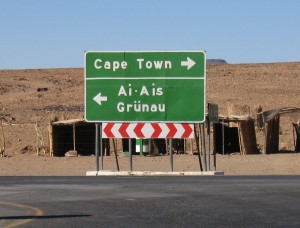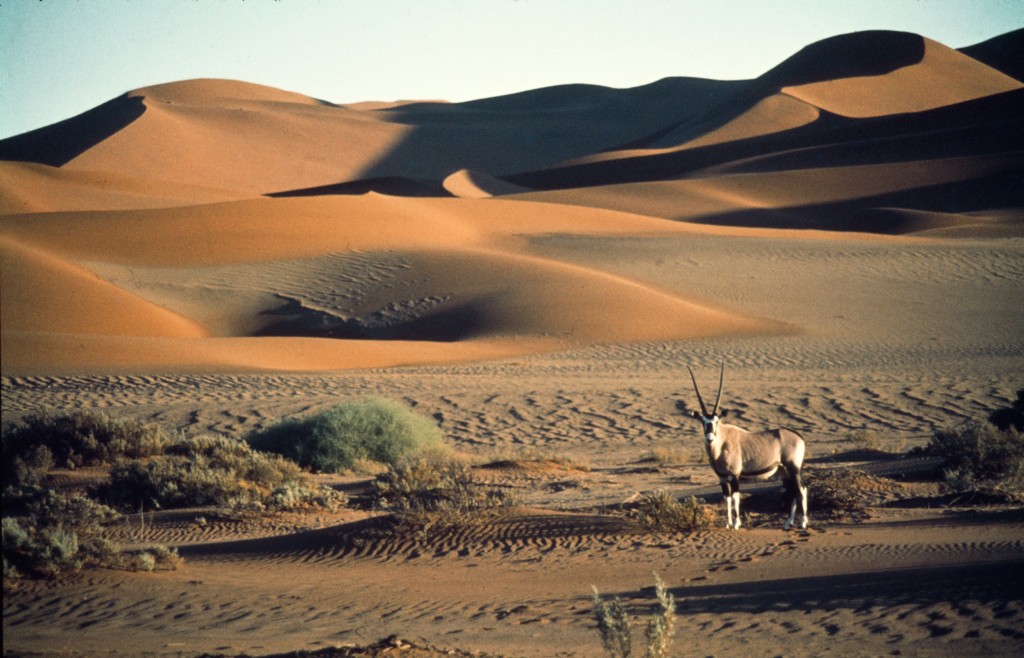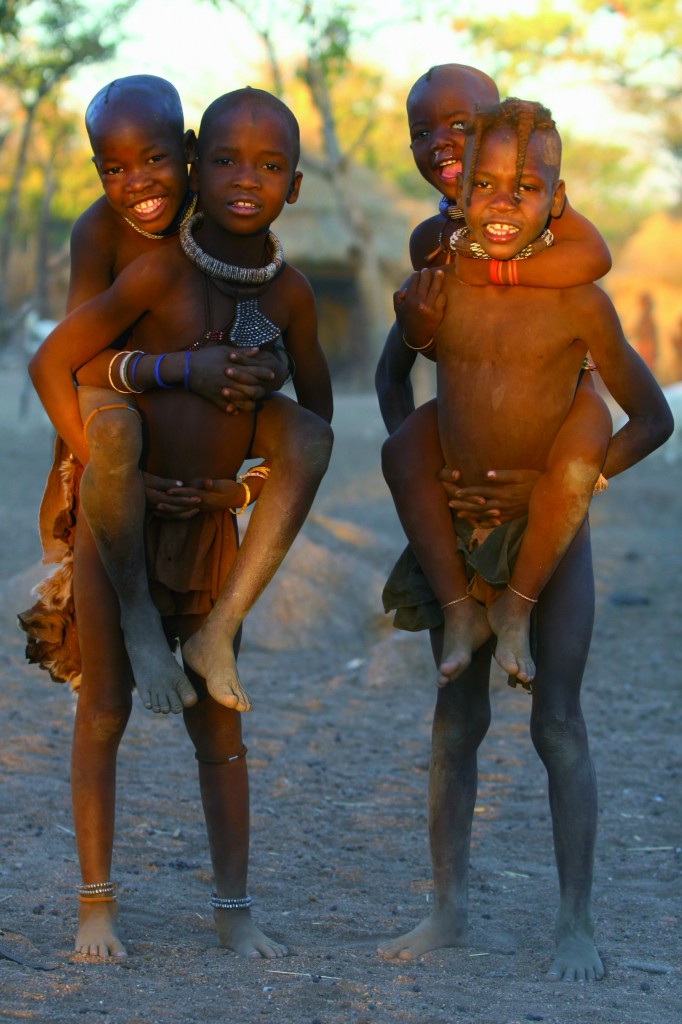Irish Times, May 15, 2010
From towering sand hills and wild savannah to Brad Pitt and Angelina Jolie,THOMAS BREATHNACH discovers the sights of Namibia, one of the world’s most sparsely populated countries

ATLANTIC WAVES crash against the Skeleton Coast as a gemsbok antelope patrols his territory, and an elephant pads over the plateaus of the Namib Desert in search of water to drink.
With scenes of such desolate magnificence it’s surprising that mention of Namibia triggers little reaction even from the most seasoned of globetrotters. Brad Pitt and Angelina Jolie made news when they had their first child here, in 2006, but otherwise the southern African country rarely makes the headlines, and although it’s a popular destination for holidaying South Africans, more widely it seems to have slipped under the travel radar, too.
But now, with the world’s biggest sporting event taking place next door next month, the former South African colony is gearing up for a World Cup tourism rush – although, with far fewer visitors seemingly on their way to southern Africa than expected, this summer you may not have to pay top Namibian dollar for a winter adventure in Africa.
I’m venturing off on a budget experience, an overland tour run by Nomad, a company that travels the length and breadth of sub-Saharan Africa on a fleet of robust yet comfortable trucks. Its 12-day Namibian Experience Tour, from Cape Town to the Namibian capital, Windhoek, takes in the natural attractions of this vast country. Our head guide, Grey, and his two assistants know them all like the back of their hand.
My fellow passengers on our truck, which is named Freddie, are an eclectic mix of Dutch and American students, a Kiwi couple in their 30s and a married Dublin woman who wants to get away from it all. She has picked the right spot: not long after crossing from South Africa into Namibia the reality of the country’s isolation sets in. You really are in the middle of nowhere. Almost 10 times the size of the island of Ireland but with less than half its population, Namibia has, after Mongolia, the lowest population density of any sovereign country, which means towns and villages are few and far between.
From the border Freddie takes us north to the tropic of Capricorn, where we are surrounded by grassland that is punctuated only by the occasional baobab tree or inselberg. Our gravel track may be a far cry from the yellow brick road, but this curious panorama of yellow vegetation beneath a burgundy evening sky is as close to a scene from The Wizard of Oz as I am ever likely to get.
The first landmark on our hit list is Dune 45, the world’s highest sand dune. Towering 300m over the Namib Desert, the drift consists of sand brought from the Kalahari Desert by the Orange River up to five million years ago. We begin our ascent early in the morning, to avoid daytime temperatures that can exceed 40 degrees. The deposits of black sand that give the dune some of its dark-pumpkin colour also help explain why the surface gets so hot as the morning progresses.
The view from the top is spectacular: mountains of sand ripple out before you as they flow to the horizon. At the foot of the dune lies Deadvlei, a white clay pan the size of a rugby field, cut off from any source of water for hundreds of years. The pan is lined with the dead trees that once thrived here, scorched black by the sun and unable to decompose because of the lack of moisture. It’s an awe-inspiring sight.
Once I have my fix of it, it’s time to slide down the slopes for the bacon and eggs that Grey is busy preparing for breakfast. The tour includes three hearty meals a day. If you’re expecting rough-and-ready bush tucker, think again. The guides cook a range of international dishes, as well as more local fare, such as potjie stews and braais.
Nomad offers camping or accommodated tours. I opt to camp, eager to experience Namibia’s natural side. Easy-to- assemble tents and mattresses are provided, and some of the camp sites on the trip let you upgrade: for about €15 extra you can stay in a luxury tent or chalet. It’s a bit like winning a challenge on Survivor , ending up with extra comfort while your fellow campers are back sleeping in their two-mans.
Travelling westwards from Dune 45, our next stint takes us to relative civilization: the sleepy town of Swakopmund, on the Namib Desert’s Atlantic coast. Namibia was once part of the German empire, and with its Lutheran church, steeply pitched roofs and geranium-filled window boxes, this could be Lower Saxony were it not for the sand sweeping the streets.
Brangelina are on the cover of almost every paper and magazine on the news stands. Grey tells us that our two days in Swakopmund have coincided with the Hollywood couple’s arrival in town – Jolie fell for Namibia while filming here in 2003, and as well as giving birth to her daughter Shiloh here, she reportedly married Pitt in a tribal wedding ceremony.
Despite getting our cameras ready to snap the stars, we’ve more chance of seeing a herd of wildebeest gallop down the main street. The Namibian government is extremely protective of the pair, threatening overly zealous photographers with arrest in addition to cordoning off the area where they’re staying.
Most Namibians belong to tribes such as the Himba, who subsist as farmers in rural areas of the country. We head to visit a Himba clan deep in the bush. We’re greeted by its leader, Vakataka, who ushers us past an acacia-thorn fence that surrounds the village and introduces us to its women and children. The women, who do much of the physical work, are tall and powerful. They and the children, who wear only loincloths, are coated inotjize , a reddish mixture of ochre, butter fat and herbs that protects them from the sun. We’re free to look around the settlement, dodging chickens and goats as we peer into their huts.
Vakataka is the only man in the village; the others are out hunting. He tells us about tribal life, whose underlying ethos is one of love and acceptance. Vakataka also gives us insights into the challenges of everyday life, including the constant battles to protect their livestock from leopards and lions.
Vakataka’s tales about brushes with big cats have me suitably excited for our next leg, to Etosha National Park, near the border with Angola. Namibia is the only country whose constitution addresses wildlife protection, so we know that a documentary’s worth of animals are waiting for us. On our game drive we see giraffes, zebras, ostriches, hyenas, elephants, lions and more, all from close range.
Our nights around the campfire at Etosha are probably when the trip reaches a crescendo. It’s here that my yearning to experience wild Africa is satisfied: I may have the protection of our tents, but there’s still an element of the unknown about who or what could make its way into our camp – other than the mischievous jackals that come within arm’s length at the sound of a can opener.
It is with sadness that I leave Namibia and its sublimely surreal scenery behind. I’ll be back some day. I know we’ll be able to pick up where we left off.
- Where to stay and go
- Nomad’s 12-day tour from Cape Town to Windhoek costs €795; nomadtours.co.za. For more on Namibia, see namibia tourism.com.na
Where to stay
- Okaukuejo Camp, Etosha National Park, 00-264-61- 2857200, nwr.com.na. Bush chalet accommodation deep in the wildlife park, Okaukuejo stands by a watering hole. Watch kudu, warthog and springbok grazing – or see what they taste like at the camp restaurant. From €55pps.
- Protea Hotel Pelican Bay. The Esplanade, Walvis Bay, 00-264-64-214000, proteahotels.com. A four-star hotel overlooking a spectacular lagoon. From €50pps.
- Sossusvlei Lodge. Sesriem, 00-27-21-9304564, sossusvleilodge.com. A popular base for exploring the dunes. Each lodge has a veranda with desert views. From €100pps.
Where to go
- Game driving at Etosha National Park (00-27-21- 8537952, etoshanationalpark. co.za). The park is almost the size of Munster, with 109 kinds of mammal and more than 300 species of bird. Thorn-filled elephant dung can puncture tyres, so drive carefully: you don’t want to have to get out to change a flat. €8 per day pass.
- Skydiving in Swakopmund (Ground Rush Adventures, 00-264-64-402841, skydive swakop.com.na). Freefalling over the Namib Desert and Atlantic Ocean will set you back about €170.
- Hiking at the Fish River Canyon. The world’s second- largest canyon, by some measures, plunges to a depth of almost 550m along its 160km course. You can see wild horses, fish eagles and giant aloes in a trek around the rim.
When to go
- March to October is the best period to visit Namibia, as it won’t be too hot and wildlife spotting is at its best. Avoid December and January.
Go there
British Airways (ba.com) flies to Windhoek from Dublin and Cork via London Heathrow and Johannesburg or Cape Town. Lufthansa (lufthansa. com) flies from Dublin via Frankfurt and Johannesburg. South African Airways (fly saa.com) flies from London Heathrow via Johannesburg or Cape Town.






